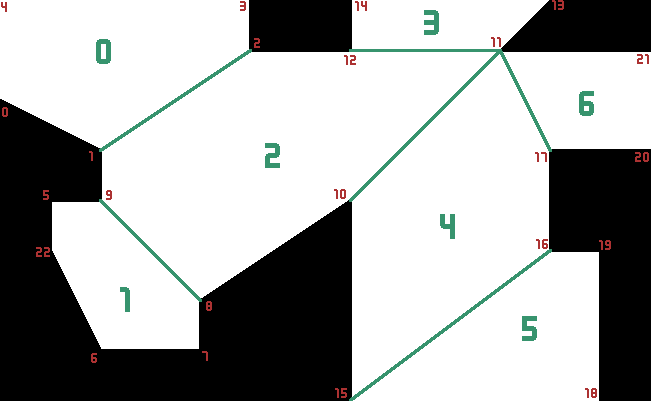
Implementation of Polyanya in Rust!
```rust use glam::Vec2; use polyanya::*;
fn main() { // Build a mesh from a list of vertices and polygons let mesh = Mesh::new( vec![ Vertex::new(Vec2::new(0., 6.), vec![0, -1]), // 0 Vertex::new(Vec2::new(2., 5.), vec![0, -1, 2]), // 1 Vertex::new(Vec2::new(5., 7.), vec![0, 2, -1]), // 2 Vertex::new(Vec2::new(5., 8.), vec![0, -1]), // 3 Vertex::new(Vec2::new(0., 8.), vec![0, -1]), // 4 Vertex::new(Vec2::new(1., 4.), vec![1, -1]), // 5 Vertex::new(Vec2::new(2., 1.), vec![1, -1]), // 6 Vertex::new(Vec2::new(4., 1.), vec![1, -1]), // 7 Vertex::new(Vec2::new(4., 2.), vec![1, -1, 2]), // 8 Vertex::new(Vec2::new(2., 4.), vec![1, 2, -1]), // 9 Vertex::new(Vec2::new(7., 4.), vec![2, -1, 4]), // 10 Vertex::new(Vec2::new(10., 7.), vec![2, 4, 6, -1, 3]), // 11 Vertex::new(Vec2::new(7., 7.), vec![2, 3, -1]), // 12 Vertex::new(Vec2::new(11., 8.), vec![3, -1]), // 13 Vertex::new(Vec2::new(7., 8.), vec![3, -1]), // 14 Vertex::new(Vec2::new(7., 0.), vec![5, 4, -1]), // 15 Vertex::new(Vec2::new(11., 3.), vec![4, 5, -1]), // 16 Vertex::new(Vec2::new(11., 5.), vec![4, -1, 6]), // 17 Vertex::new(Vec2::new(12., 0.), vec![5, -1]), // 18 Vertex::new(Vec2::new(12., 3.), vec![5, -1]), // 19 Vertex::new(Vec2::new(13., 5.), vec![6, -1]), // 20 Vertex::new(Vec2::new(13., 7.), vec![6, -1]), // 21 Vertex::new(Vec2::new(1., 3.), vec![1, -1]), // 22 ], vec![ Polygon::new(vec![0, 1, 2, 3, 4], true), // 0 Polygon::new(vec![5, 22, 6, 7, 8, 9], true), // 1 Polygon::new(vec![1, 9, 8, 10, 11, 12, 2], false), // 2 Polygon::new(vec![12, 11, 13, 14], true), // 3 Polygon::new(vec![10, 15, 16, 17, 11], false), // 4 Polygon::new(vec![15, 18, 19, 16], true), // 5 Polygon::new(vec![11, 17, 20, 21], true), // 6 ], );
// Get the path between two points
let from = Vec2::new(12.0, 0.0);
let to = Vec2::new(3.0, 1.0);
let path = mesh.path(from, to);
assert_eq!(
path.unwrap().path,
vec![
Vec2::new(7.0, 4.0),
Vec2::new(4.0, 2.0),
Vec2::new(3.0, 1.0)
]
);
} ```
The code above will build the folowwing mesh, with polygons marked in green:

Check the cpp implementation.
The mesh files used in tests are coming from the cpp implementation and are available under MIT license.